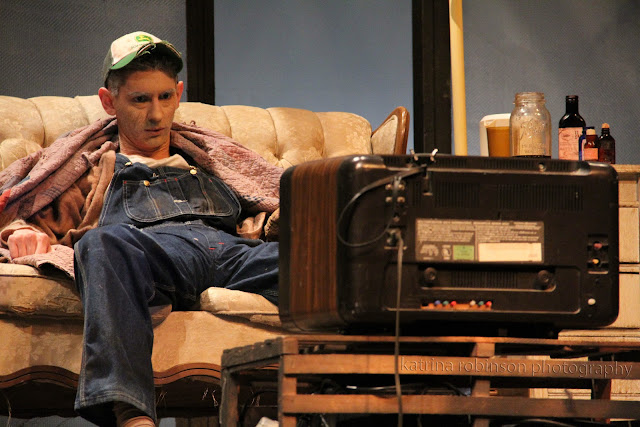 |
| A scene from "Christmas by the Fireside" |
review by Janet I. Martineau
A sound effects man bleating like a lamb. A thin Santa Claus dressed in a snazzy black suit and with jet black hair. An angel with the devil in her body English.
Gosh these old-time radio shows presented by the Saginaw Valley State University Theater Department are such great fun -- and this year’s installment in the series was the funnest. Sadly it opened last night and ends tonight.
The first two were old warhorses -- “A Christmas Carol” and “It’s a Wonderful Life” as adapted and co-directed by SVSU professors Richard B. Roberts and David Rzeszutek. This one, titled “Christmas by the Fireside: A 1940’s Radio Show,” was all theirs -- set in Christmas Eve 1943, the combing of four short stories, snippets of probably a dozen Christmas carols, commercials paying tribute to Saginaw’s Potter Street Station, Savoy Grill, Morley’s Department store, Heavenrich’s, Provenzano’s....and.....
...And... the recorded voice of President Franklin D. Roosevelt himself delivering a wartime fireside chat that still speaks to today's America.
Oh, and there was that hilarious ad (more like an ode) for Spam and its many uses.
What was not to love about a trip down memory lane like that, and to hear stories read to us just like when we were kids.
The stories? One I have never heard about the wandering lamb who kept newborn Jesus warm on the night he was born (and which brought tears to this animal lover). “The Toymaker and the Elf.” The true story about the Christmas night in 1914 Belgium when the German troops and the Brits declared a truce, sang “Silent Night” in German and English, and even exchanged gifts (that one also hit home since my dad fought in World War I and often told the story although he was not there). And how ‘Twas the Night Before Christmas” came to be written by an overworked father (appealing to the poetry fan in me).
As usual with these productions, the cast members play roles within roles -- their off-microphone radio show actors milling about the stage before the show begins and then as the characters they play in the four stories being told. Great fun to watch, and to see four theater department “adults” acting alongside their 20 students in this one.
The costumes were also a trip down 1943’s memory lane and made for a colorful montage. And those sound effects people are always a hoot to watch. If there is a complaint, it is that the sound was a little too hot on the ears with the spoken words.
All of which adds up to the realization these old-time radio shows -- in a world when other than the studio audiences the rest of the nation only heard and never saw -- lead to Technicolor creations often more vibrant than the the more traditional live theater productions. More vibrant and almost too much to take in when it comes to the many layers of action.
At the end “announcers” Roberts and Rzeszutek told their radio audience that next year’s old-time radio show will be “Miracle on 34th Street.” It will indeed take a miracle to top this year’s “Fireside Chat.”





